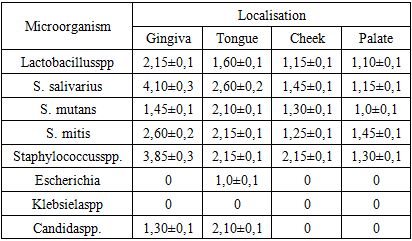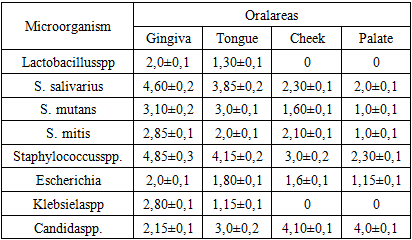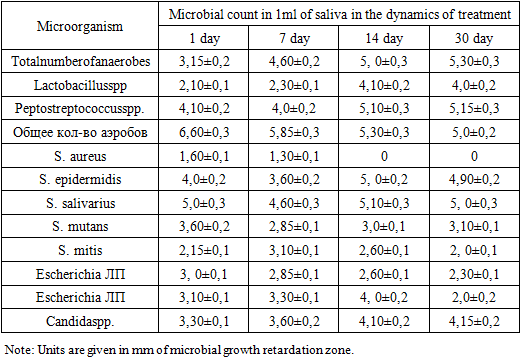-
Paper Information
- Next Paper
- Previous Paper
- Paper Submission
-
Journal Information
- About This Journal
- Editorial Board
- Current Issue
- Archive
- Author Guidelines
- Contact Us
American Journal of Medicine and Medical Sciences
p-ISSN: 2165-901X e-ISSN: 2165-9036
2025; 15(4): 943-946
doi:10.5923/j.ajmms.20251504.20
Received: Mar. 3, 2025; Accepted: Mar. 23, 2025; Published: Apr. 6, 2025

Study of the Influence of Infrared Radiation on the Effectiveness of Complex Treatment of Mandibular Fractures Using Microbiological Methods
Rakhimov Zokir Kayimovich
Bukhara State Medical Institute, Bukhara, Uzbekistan
Correspondence to: Rakhimov Zokir Kayimovich, Bukhara State Medical Institute, Bukhara, Uzbekistan.
| Email: |  |
Copyright © 2025 The Author(s). Published by Scientific & Academic Publishing.
This work is licensed under the Creative Commons Attribution International License (CC BY).
http://creativecommons.org/licenses/by/4.0/

Purpose of the study. This study is aimed at revealing the microbiological effectiveness of using infrared radiation in the complex therapy of patients with mandibular fractures in order to prevent inflammatory complications. To fulfil this objective, 105 patients with diagnosed uncomplicated mandibular fractures without concomitant pathologies and 15 healthy volunteers were examined. The study participants were divided into two groups: a control group consisting of 50 patients with mandibular fractures who were treated with standard therapy and a main group consisting of 55 patients who were treated with infrared laser radiation. In all patients with fractures of the jaw a comparative analysis of the microflora composition with the microflora indicators of healthy people was carried out. In addition, dynamic microbiological studies were performed in patients suffering from mandibular fractures during the observation period (1, 7, 14 and 30 days). Results. Patients with jaw fractures showed an increased prevalence of microorganisms in the oral cavity compared to healthy individuals. Escherichia coli and fungi of the genus Candida were detected in all areas of the oral cavity examined, while Klebsiella were found in only two of the four areas (gingival and tongue). When infrared radiation was added to the standard treatment of patients with jaw fractures, no S. aureus was detected by the 30th day of observation, in contrast to the control group, and a decrease in the number of S. mitis and S. mutans was observed. Conclusion. The obtained positive results of microbiological studies conducted in the process of dynamic monitoring of treatment give confidence in the expediency of wide application of infrared irradiation within the framework of complex pathogenetic therapy of traumatic injuries of the mandible in order to prevent infectious-inflammatory complications.
Keywords: Mandibular fracture, Infrared laser radiation, Microorganisms
Cite this paper: Rakhimov Zokir Kayimovich, Study of the Influence of Infrared Radiation on the Effectiveness of Complex Treatment of Mandibular Fractures Using Microbiological Methods, American Journal of Medicine and Medical Sciences, Vol. 15 No. 4, 2025, pp. 943-946. doi: 10.5923/j.ajmms.20251504.20.
1. Introduction
- In recent decades, there has been a pronounced trend towards increasing cases of general traumatism, including injuries of the maxillofacial region. In the general structure of injuries to the bones of the facial skeleton, mandibular fractures account for 65 - 94 % [1,5,8]. Patients with this type of injuries account for 22.4 - 33% of the total number of patients hospitalised in maxillofacial surgery hospitals. A characteristic feature of mandibular fractures is a high probability of complications, primarily inflammatory. According to the literature, the frequency of their occurrence reaches 37.2% [2,3,4,6], 41% and 55.1% [7], with osteomyelitis being diagnosed in 16.8% of cases. As Grinev M.V. notes, ‘It is difficult to find another surgical disease that could compete with osteomyelitis in terms of the number of unfavourable outcomes, number of recurrences and duration of the disease’ [11,12,13]. All this does not allow us to speak about the effectiveness of the current approach to the treatment of this category of patients, and requires the development of ways to improve it.The search for new therapeutic methods aimed at effective prevention of post-traumatic complications represents one of the urgent tasks of dentistry. In the field of maxillofacial surgery, there is a growing interest in non-medication approaches to treatment. For example, physiotherapeutic methods are actively used to relieve pain, reduce oedema and tissue infiltration, and stimulate blood supply in the fracture area. The biological effects of infrared (IR) irradiation were first discovered in cell cultures, microorganisms and plants. Modern researchers studying the primary mechanisms of the effects of infrared (IR) radiation present evidence that it interacts with photoacceptor molecules, which in turn leads to an acceleration of electron transfer in the respiratory chain. This occurs due to changes in the redox properties of the chain components when they are photoexcited. Some works also describe the effect of activation of oxidative metabolism under the influence of IR radiation. Studies show that infrared irradiation stimulates regional blood flow in the area of pathological focus, activates chemotaxis of leukocytes in inflammation zones, and also promotes activation of proteolytic enzymes. Irrespective of the zone of exposure, IR radiation activates the body's natural defence mechanisms, such as phagocytosis and lysozyme activity, as well as desensitising mechanisms. In addition, infrared rays have been found to have analgesic, antispasmodic and anti-inflammatory effects, as well as being able to stimulate general metabolism.Thus, the problem of creating and improving methods of treatment and prevention of complications in patients with mandibular fractures remains relevant today.The aim of this study is - to evaluate the effectiveness of infrared radiation in the complex treatment of such patients to prevent inflammatory complications.
2. Materials and Methods
- To achieve this objective, 105 patients diagnosed with uncomplicated mandibular fracture (UFJ) and 15 healthy volunteers were included in the study. The age of the participants ranged from 18 to 60 years, 78 (65%) males, 27 (35%) females. Patients were divided into two groups. The comparison group consisted of 50 patients with PHF and received standard treatment. In contrast, the main group consisted of 55 patients and infrared laser irradiation was used for combined treatment.Fixation of bone fragments in both groups was performedorthopaedically using a Tigerstedt wire splint for fixation of mandibular fragments and intermaxillary rubber traction. General treatment included intramuscular injections of cephalosporin antibiotics, intraoral treatment with antiseptics and symptomatic treatment.In all patients with jaw fractures, a comparative evaluation of the isolated microflora was carried out with that of healthy individuals. For this purpose, once, at the initial treatment of patients, material was collected from the surface of the mucous membrane of the attached gingiva, back of the tongue, cheeks and hard palate using sterile swabs.Microbiological studies were performed in patients with PUF on days 1, 7, 14 and 30 of observation. For this purpose, the method of oral fluid sampling by rinsing the oral mucosa was used. Highly selective nutrient media (‘Xi Media’, India) were used in microbiological analyses. Pathogens were isolated and cultured on blood agar, Endo agar, milk-salt agar and Sabouraud medium under standard conditions: 18-24 hours at 37°C. Anaerostat and gas generator bags were used to isolate anaerobic microorganisms. After the specified time, Petri dishes were removed from the thermostat, after which microorganism colonies were counted and the group and species identity of isolated colonies was determined.The obtained data were statistically processed using the software packages ‘Statistica 10.0’ and ‘Excel’. Before applying the methods of descriptive statistics, the type of distribution of quantitative features was determined using the Shapiro-Wilk criterion. The arithmetic mean (M) and standard error of the mean (m) were calculated for signs with normal distribution.
3. Results and Discussion
- In the course of microbiological study, an analysis of the isolated microflora in the area of the mucous membrane of the tongue body, cheek, attached gingiva and palate in healthy individuals and in patients with mandibular fracture was performed (Tables 1, 2). It was revealed that the density of microbial colonisation in the oral cavity depends on the localisation. The highest number of microbes in healthy individuals was found in the gingival mucosa (4.20±0.3 CFU ̸ cm2), the lowest - in the palatal mucosa (1.25±0.1 CFU ̸ cm2). The Gram-positive flora was predominant in number and species composition in the biocenosis, isolated in 100% of cases. It was determined that the leading role in colonisation of the oral cavity of healthy individuals is played by representatives of the genus Streptococcus, with S. salivarius being the dominant species.
|
|
|
|
4. Conclusions
- Thus, the data obtained allow us to conclude that patients with jaw fractures have a higher prevalence of microorganisms in the oral cavity compared to healthy individuals. In particular, Escherichia coli and Candida fungi were detected in all the studied areas of the oral cavity, and Klebsiella were detected in two of the four studied sites (in the gum and tongue areas). The inclusion of infrared radiation in the standard therapy of patients with jaw fractures leads to the absence of S. aureus by day 30 of observation, in contrast to the control group, as well as to the reduction of S. mitis and S. mutans. The search for new, more effective methods of treatment of jaw fractures remains relevant. The use of infrared laser radiation for the prevention of inflammation caused by injuries of the maxillofacial region looks very promising.
 Abstract
Abstract Reference
Reference Full-Text PDF
Full-Text PDF Full-text HTML
Full-text HTML


